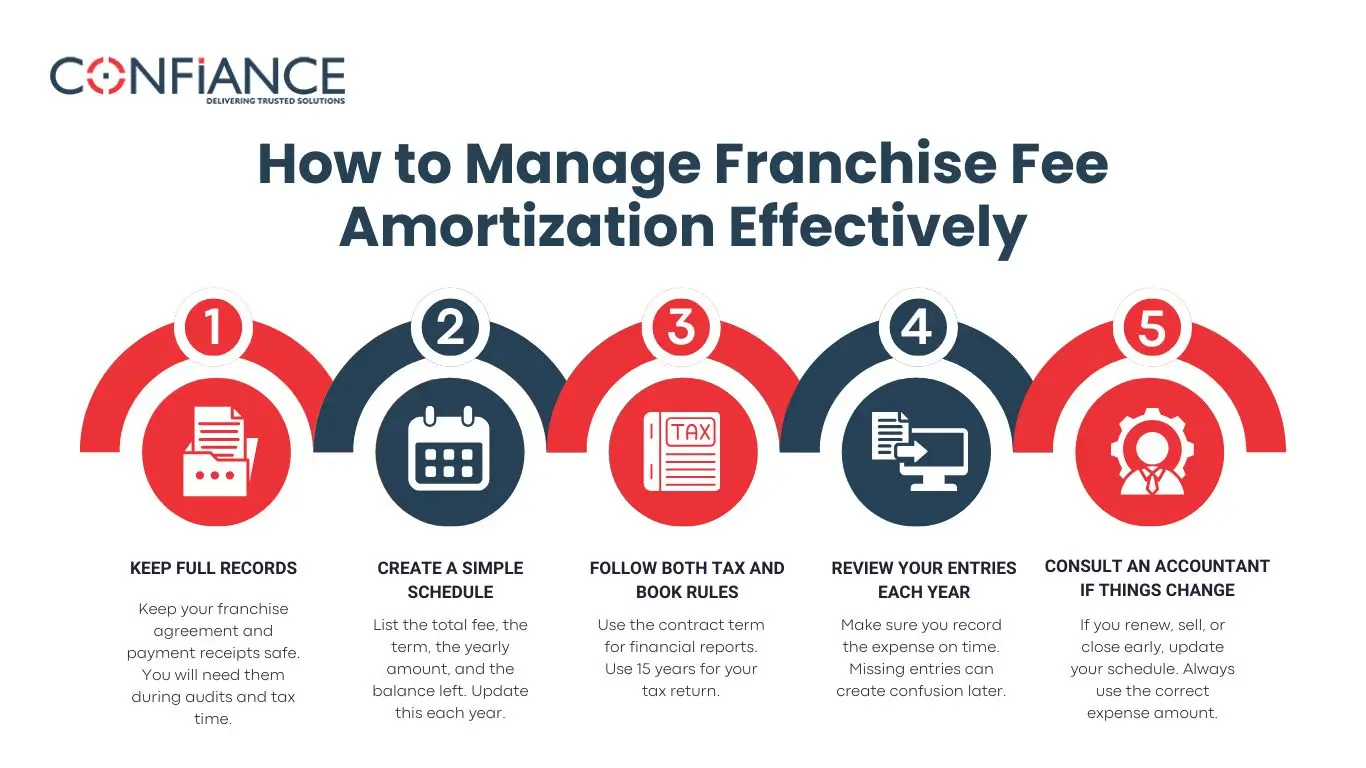
All You Need to Know About Franchise Fee Amortization
If you open a franchise, you will likely pay an upfront franchise fee. This fee allows you to use the brand, systems, and support from the franchisor. You cannot treat this fee as a one-time cost. Instead, you must spread it over time through amortization. This guide explains how franchise fee amortization works and why it matters.
What Is a Franchise Fee and Franchise Fee Amortization?
A franchise fee is a payment that is made by a franchisee to a franchisor. It is paid at the start of the agreement. This fee gives the franchisee the right to run a business under the franchisor’s brand. It covers training, startup support, and brand use.
The fee is often a fixed amount. It often ranges between $10,000 and $50,000, but can be higher. This cost is separate from royalties or other ongoing fees. You pay it only once before the business starts.
Why You Cannot Expense It Right Away
Expense cannot be calculated fully as a fee in the first year. The benefit of the fee lasts several years. Accounting rules say you must match expenses to the time they help the business. This rule is known as the matching principle.
Because the franchise fee supports the business over time, it must be recorded that way. You spread the cost across the life of the agreement. This avoids showing a big loss in year one.
Franchise Fee Amortization
Franchise fee amortization means dividing the fee into equal yearly expenses. Instead of showing the entire cost in one year, you spread it over the full term of the franchise. This gives a fair view of profits and helps meet accounting rules.
If you pay $60,000 for a 10-year agreement, you would expense $6,000 each year. This amount is presented as an expense on the income statement. The value of the asset is reduced by the same amount on the balance sheet.
How to Amortize Franchise Fee
You can amortize franchise fee by following these steps:
- Find the total fee paid
Use only the part paid to secure the right to operate the franchise. - Check the terms of the agreement
Most franchise contracts last 5 to 10 years. - Use the straight-line method
Divide the fee evenly by the number of years. This gives you the yearly amount to expense. - Record the expense each year
Decrease the asset value and show the same amount as an expense. - Adjust if the agreement ends early
If the franchise closes early, write off the remaining balance.
IRS Rules on Amortization
For tax purposes, the IRS has its own set of rules. Under Section 197 of the tax code, you must amortize franchise fees over 15 years. This rule applies even if your franchise term is shorter. You must follow this for tax returns.
You will need to keep two sets of records. Use the actual franchise term for your business accounting. This shows the cost matched to the agreement period. For your tax filings, follow IRS rules and use a 15-year amortization period, even if your contract is shorter. Keep both schedules updated to avoid mistakes in financial reports and tax returns.
Impact on Financial Reports
Amortization spreads out a large cost. This gives a smoother view of profits over time. It also avoids sharp drops in net income during the first year.
Each year, the expense lowers taxable income. Even though the money was paid upfront, you get to deduct a part of it every year. This helps with tax planning.
The balance sheet will show the franchise fee as an asset. This asset goes down each year as you record the amortization expense.
If You Sell or Close the Franchise Early
If you sell the franchise, the remaining balance of the franchise fee becomes part of your cost basis. This affects how much profit or loss you report from the sale. If the business shuts down early, you may need to expense the unpaid balance right away.
Talk to an accountant when this happens. The treatment may depend on your deal terms and how much of the fee is left.
Common Terms You Should Know
- Franchise Fee: One-time cost paid to start a franchise.
- Amortization: The method used to spread the cost of intangible assets across the years they provide value.
- Straight-Line Method: Equal amount expensed each year.
- Section 197: IRS rule that applies to intangible asset amortization.
- Impairment: Immediate write-off of asset value due to changes in business.
How to Manage Franchise Fee Amortization Effectively

- Keep full records
Keep your franchise agreement and payment receipts safe. You will need them during audits and tax time.
- Create a simple schedule
List the total fee, the term, the yearly amount, and the balance left. Update this each year.
- Follow both tax and book rules
Use the contract term for financial reports. Use 15 years for your tax return.
- Review your entries each year
Make sure you record the expense on time. Missing entries can create confusion later. - Consult an accountant if things change
If you renew, sell, or close early, update your schedule. Always use the correct expense amount.
Common Errors in Franchise Fee Amortization
- Expensing the full amount at once
This can make your income statement look worse than it should. - Ignoring the IRS 15-year rule
This can cause tax problems or trigger penalties. - Combining franchise fees with other startup costs
Only the franchise fee should be amortized this way. - Failing to update your schedule
If the agreement changes, update your records right away. - Not writing off the balance if the franchise ends early
This can lead to misstated financials or missed deductions.
Franchise fee amortization is required when you buy into a franchise. It helps you match the cost to the years you benefit from the agreement. It also gives a more accurate view of profits and keeps your records in line with tax law.
Make sure you apply both financial and tax rules. Use the agreement term for your business books. Use 15 years for tax reporting. Keep track of each year's expenses and the balance left.
If you sell or close the business, adjust your records. Write off any remaining balance if the contract ends early. When in doubt, ask your accountant to guide you.
By learning to amortize franchise fees correctly, you stay compliant and avoid errors. You can better plan your business with Confiance’s franchise accounting services. Our services cover all the models of franchise business and help them plan for the future.
Summary
- A franchise fee is a single upfront payment that gives you the right to operate under a brand.
- You are not allowed to deduct the entire fee in the first year.
- You must amortize it over the life of the franchise agreement.
- The IRS requires you to use a 15-year term for tax purposes.
- Good records and correct entries help avoid mistakes.
FAQs
- What is franchise fee amortization?
It means spreading the franchise fee over the years of the agreement instead of expensing it all at once. - How do I amortize a franchise fee?
Divide the total fee by the number of years in the contract. Expense that amount each year. - Why do I need to amortize the fee?
The fee gives long-term benefits. Amortizing matches the cost to the years you use it. - Can I write off the fee in one year?
No. You must spread it out, even if you paid it upfront. - What if I end the agreement early?
You write off the unpaid balance as an expense when the franchise ends.
